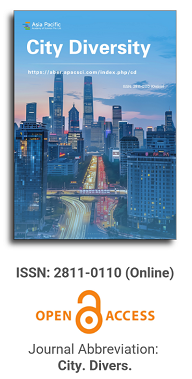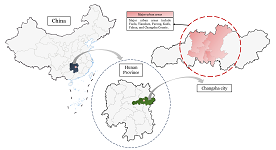
Asia Pacific Academy of Science Pte. Ltd. (APACSCI) specializes in international journal publishing. APACSCI adopts the open access publishing model and provides an important communication bridge for academic groups whose interest fields include engineering, technology, medicine, computer, mathematics, agriculture and forestry, and environment.

As China's pillar industry, the property market has suffered a considerable impact in recent years, with a decline in turnover and many developers at risk of bankruptcy. As one of the most concerned factors for stakeholders, housing prices need to be predicted more objectively and accurately to minimize decision-making errors by developers and consumers. Many prediction models in recent years have been unfriendly to consumers due to technical difficulties, high data demand, and varying factors affecting house prices in different regions. A uniform model across the country cannot capture local differences accurately, so this study compares and analyses the fitting effects of multiple machine learning models using February 2024 new building data in Changsha as an example, aiming to provide consumers with a simple and practical reference for prediction methods. The modeling exploration applies several regression techniques based on machine learning algorithms, such as Stepwise regression, Robust regression, Lasso regression, Ridge regression, Ordinary Least Squares (OLS) regression, Extreme Gradient Boosted regression (XGBoost), and Random Forest (RF) regression. These algorithms are used to construct forecasting models, and the best-performing model is selected by conducting a comparative analysis of the forecasting errors obtained between these models. The research found that machine learning is a practical approach to property price prediction, with least squares regression and Lasso regression providing relatively more convincing results.
Empowering communities through art: Unleashing the potential of public art in urban micro-renewal
Vol 6, Issue 1, 2025
Download PDF
Abstract
As urban space available for new construction continues to diminish, urban renewal strategies have increasingly shifted toward micro-renewal approaches. Within this framework, public art serves as a vital medium for urban cultural development and has been effectively integrated into community spaces under the paradigm of human-centered urban micro-renewal. This study systematically explores the forms, principles, and mechanisms of community public art. First, it establishes the synergistic relationship between urban micro-renewal and community public art. It then identifies six distinct artistic forms: spatial transformation, sculptural installations, murals and wall paintings, public facilities, digital media, and artistic events. Building upon this classification, the study delineates four core principles that community public art should adhere to: the participatory principle of human-centered engagement, the principle of locality emphasizing cultural distinctiveness, the principle of gradual progression ensuring sustainable development, and the social principle of art education. Through comparative case analysis, the study reveals the multidimensional role of community public art in restructuring power dynamics, driving community transformation, and reshaping cultural identity. The findings demonstrate that community public art not only enhances the spatial environment and improves community quality but also fosters social integration and strengthens cultural identity, providing an innovative pathway for urban governance. Finally, the study acknowledges its limitations and outlines future research directions, aiming to contribute to both theoretical discourse and practical applications in community public art.
Keywords
References
1. Haaland C, van Den Bosch CK. Challenges and strategies for urban green-space planning in cities undergoing densification: A review. Urban forestry & urban greening. 2015; 14(4): 760-771. doi: 10.1016/j.ufug.2015.07.009
2. Quinn B. Arts festivals and the city. Culture-led urban regeneration; 2020.
3. Collins CR, Neal ZP, Neal JW. Transforming social cohesion into informal social control: Deconstructing collective efficacy and the moderating role of neighborhood racial homogeneity. Journal of Urban Affairs. 2017; 39(3): 307-322. doi: 10.1080/07352166.2016.1245079
4. Stone S. UnDoing buildings: Adaptive reuse and cultural memory. Available online: https://www.taylorfrancis.com/books/mono/10.4324/9781315397221/undoing-buildings-sally-stone (accessed on 10 January 2025).
5. Jian IY, Luo J, Chan EH. Spatial justice in public open space planning: Accessibility and inclusivity. Habitat International; 2020. doi: 10.1016/j.habitatint.2020.102122
6. Beeckmans L, Gola A, Singh A, Heynen H. Making home (s) in displacement: Critical reflections on a spatial practice. Leuven University Press; 2022.
7. Nassar UAE. Urban acupuncture in large cities: filtering framework to select sensitive urban spots in riyadh for effective urban renewal. Journal of Contemporary Urban Affairs. 2021; 5(1): 1-18. doi: 10.25034/ijcua.2021.v5n1-1
8. Zhang W, Zhang X, Wu G. The network governance of urban renewal: A comparative analysis of two cities in China. Land Use Policy; 2021. doi: 10.1016/j.landusepol.2021.105448
9. Couch C, Sykes O, Börstinghaus W. Thirty years of urban regeneration in Britain, Germany and France: The importance of context and path dependency. Progress in planning. 2011; 75(1): 1-52. doi: 10.1016/j.progress.2010.12.001
10. Guinard P, Margier A. Art as a new urban norm: Between normalization of the City through art and normalization of art through the City in Montreal and Johannesburg. Cities. 2018; 77: 13-20. doi: 10.1016/j.cities.2017.04.018
11. Aelbrecht P, Stevens Q. Public space design and social cohesion: An international comparison. Routledge; 2019.
12. Qu M, Cheer JM. Community art festivals and sustainable rural revitalization. In: Events and sustainability. Routledge; 2022.
13. Qu M, Zollet S. Neo-endogenous revitalisation: Enhancing community resilience through art tourism and rural entrepreneurship. Journal of Rural Studies. 2023; 97: 105-114. doi: 10.1016/j.jrurstud.2022.11.016
14. Mehta V, Bosson JK. Revisiting Lively Streets: Social Interactions in Public Space. Journal of Planning Education and Research. 2021; 41(2): 160-172. doi: 10.1177/0739456X18781453
15. Meyrick J, Barnett T. From public good to public value: arts and culture in a time of crisis. Cultural Trends. 2021; 30(1): 75-90. doi: 10.1080/09548963.2020.1844542
16. Fuller M, Moore R. An Analysis of Jane Jacobs’s The Death and Life of Great American Cities. Macat Library; 2017.
17. Jacobs J. The death and life of great American cities. Available online: https://www.buurtwijs.nl/sites/default/files/buurtwijs/bestanden/jane_jacobs_the_death_and_life_of_great_american.pdf (accessed on 10 January 2025).
18. Mumford L. The city in history: Its origins, its transformations, and its prospects. Available online: https://archive.org/details/cityinhistoryits0000mumf/page/n5/mode/2up (accessed on 10 January 2025).
19. Alexander C. A city is not a tree. Sustasis Press Association with Center for Environmental Structure. Available online: https://fenix.tecnico.ulisboa.pt/downloadFile/1126518382241329/Christopher_Alexander_A_city_is_not_a_tree.pdf (accessed on 10 January 2025).
20. Alexander C. A pattern language: towns, buildings, construction. Oxford university press; 1977.
21. Attoe W, Logan D. American urban architecture: Catalysts in the design of cities. Univ of California Press; 1989.
22. Rowe C, Koetter F. Collage city. Available online: https://www.librinlinea.it/titolo/collage-city-dazzi-chiara-rowe-colin/SBL0308025 (accessed on 10 January 2025).
23. Heath T, Oc T, Tiesdell S. Revitalising historic urban quarters. Routledge; 2013. doi: 10.1080/09654310500139558
24. Schumacher EF. Small is beautiful: A study of economics as if people mattered. Available online: https://sciencepolicy.colorado.edu/students/envs_5110/small_is_beautiful.pdf (accessed on 10 January 2025).
25. Helguera P. Socially engaged art. Available online: http://www.billkelleyjr.net/download/helguera-education-week-1-2.pdf (accessed on 10 January 2025).
26. Hongyi W. Space Transition of New Genre Public Art. Public Art; 2014.
27. Lacy S. Time in place: New genre public art a decade later. In: the practice of public art. Routledge; 2008.
28. Miles M. Art, space and the city: public art and urban futures. Psychology Press; 1997.
29. Juskowiak P. Krzysztof Wodiczko’s Community Art. Around the Poznań Projection 1 (Polish). Praktyka teoretyczna. 2010; 1: 67-80. doi: 10.14746/prt.2010.1.5
30. Sun L, Fan X. Research on the Application of New Public Art in Older Community Spaces. Industrial Design; 2022.
31. Fan X. A study of new types of public art’s micro-intervention in community space. Public Art; 2020.
32. Mendelson-Shwartz E, Mualam N. Challenges in the creation of murals: A theoretical framework. Journal of Urban Affairs. 2022; 44(4-5): 683-707. doi: 10.1080/07352166.2021.1874247
33. Takala GB. The interactive creativity of the digital era: Exploring how media art redefines the relationship between audience and artwork. Studies in Art and Architecture; 2023.
34. Jung TH, Lee J, Yap MH, Ineson EM. The role of stakeholder collaboration in culture-led urban regeneration: A case study of the Gwangju project, Korea. Cities. 2015; 44: 29-39. doi: 10.1016/j.cities.2014.12.003
35. Redaelli E. Creative placemaking and the NEA: unpacking a multi-level governance. Policy Studies. 2016; 37(4): 387-402. doi: 10.1080/01442872.2016.1157857
36. Baú V. Citizen engagement in peacebuilding: A communication for development approach to rebuilding peace from the bottom-up. Progress in Development Studies. 2016; 16(4): 348-360. doi: 10.1177/1464993416663052
37. Kester GH. The One and the Many: Contemporary Collaborative Art in a Global Context. Duke University Press; 2011. doi: 10.1515/9780822394037
38. Hazbei M, Cucuzzella C. Revealing a Gap in Parametric Architecture’s Address of “Context”. Buildings. 2023; 13(12): 3136. doi: 10.3390/buildings13123136
39. Ruggerio CA. Sustainability and sustainable development: A review of principles and definitions. Science of the Total Environment. 2021. doi: 10.1016/j.scitotenv.2021.147481
40. Cucuzzella C, Hazbei M, Goubran S. Activating data through eco-didactic design in the public realm: Enabling sustainable development in cities. Sustainability. 2021; 13(8): 4577. doi: 10.3390/su13084577
41. Chupin JP, Hazbei M, Pelchat KA. Three Types of Architectural Educational Strategies (AES) in Sustainable Buildings for Learning Environments in Canada. Sustainability. 2021; 13(15). doi: 10.3390/su13158166
42. Angelo H. How green became good: Urbanized nature and the making of cities and citizens. University of Chicago Press; 2021.
43. eLSeed. Perception Cairo Egypt El Seed Art. Available online: https://elseed-art.com/projects/perception-cairo/ (accessed on 10 January 2025).
44. Gold JR, Gold MM. Olympic cities: Regeneration, city rebranding and changing urban agendas. In: The Olympics. Routledge; 2023
45. Lang S, Rothenberg J. Neoliberal urbanism, public space, and the greening of the growth machine: New York City’s High Line Park. Environ Plan A. 2017; 49(8): 1743-1761. doi: 10.1177/0308518X16677969
46. Naguib SA. Engaged ephemeral art: Street art and the Egyptian Arab Spring. The Journal of Transcultural Studies. 2016; 7(2): 53-88. doi: 10.17885/heiup.ts.2016.2.23590
47. Eldin FA, Abdelwahab MA, Sherif L. Mural Arts in Historic Cairo: A Critical Review. In: Shahidan MF, Salih GHA, Cardaci A, Mahmoud IH (editors). Urban Narratives: Exploring Identity, Heritage, and Sustainable Development in Cities. Advances in Science, Technology & Innovation. Cham: Springer Nature Switzerland; 2024.
48. Pappalepore I, Duignan MB. The London 2012 cultural programme: A consideration of Olympic impacts and legacies for small creative organisations in east London. Tourism Management; 2016.
49. Virani TE. Exploring the Relationship Between Creative Hubs and Urban Policy in East London. In: Question R, Gill A, Pratt C, Virani TE (editors). Dynamics of Virtual Work. Cham: Springer International Publishing; 2019.
Supporting Agencies
Copyright (c) 2025 Author(s)
License URL: https://creativecommons.org/licenses/by/4.0/

This site is licensed under a Creative Commons Attribution 4.0 International License (CC BY 4.0).

Prof. Mehmet Cetin
Kastamonu University,
Turkey
Polish Scientific Bibliography

